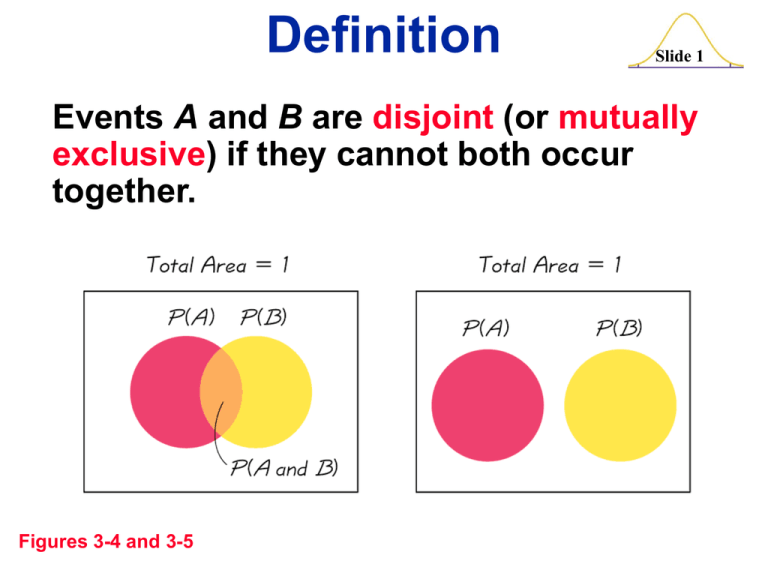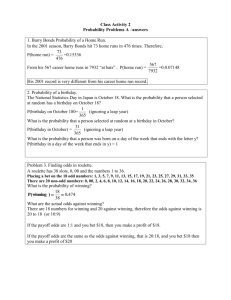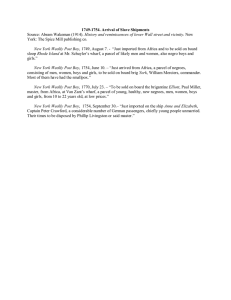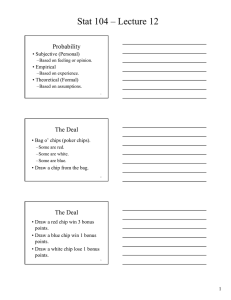CHAPTER 4 add
advertisement

Definition Slide 1 Events A and B are disjoint (or mutually exclusive) if they cannot both occur together. Figures 3-4 and 3-5 Example Slide 2 Titanic Passengers Survived Died Total Men 332 1360 1692 Women 318 104 422 Boys 29 35 64 Girls 27 18 56 Totals 706 1517 2223 Find the probability of randomly selecting a man or a boy. Example Survived Died Total Men 332 1360 1692 Women 318 104 422 Boys 29 35 64 Slide 3 Girls 27 18 56 Totals 706 1517 2223 Find the probability of randomly selecting a man or a boy. P(man or boy) = 1692 + 64 = 1756 = 0.790 2223 2223 2223 * Disjoint * Example Survived Died Total Men 332 1360 1692 Women 318 104 422 Boys 29 35 64 Slide 4 Girls 27 18 45 Totals 706 1517 2223 Find the probability of randomly selecting a man or someone who survived. Example Survived Died Total Men 332 1360 1692 Women 318 104 422 Boys 29 35 64 Slide 5 Girls 27 18 45 Totals 706 1517 2223 Find the probability of randomly selecting a man or someone who survived. P(man or survivor) = 1692 + 706 – 332 = 2066 2223 2223 2223 2223 = 0.929 * NOT Disjoint * Complementary Events Slide 6 P(A) and P(A) are mutually exclusive All simple events are either in A or A. Rules of Complementary Events P(A) + P(A) = 1 P(A) = 1 – P(A) P(A) = 1 – P(A) Slide 7 Venn Diagram for the Complement of Event A Figure 3-7 Slide 8 Notation Slide 9 P(A and B) = P(event A occurs in a first trial and event B occurs in a second trial) Example Important Principle Slide 10 Probability for the second event B should take into account the fact that the first event A has already occurred. Notation for Conditional Probability Slide 11 P(B A) represents the probability of event B occurring after it is assumed that event A has already occurred (read B A as “B given A.”) Definitions Slide 12 Independent Events Two events A and B are independent if the occurrence of one does not affect the probability of the occurrence of the other. (Several events are similarly independent if the occurrence of any does not affect the occurrence of the others.) If A and B are not independent, they are said to be dependent. Formal Multiplication Rule Slide 13 P(A and B) = P(A) • P(B A) Note that if A and B are independent events, P(B A) is really the same as P(B) Applying the Multiplication Rule Slide 14 Summary of Fundamentals Slide 15 In the addition rule, the word “or” on P(A or B) suggests addition. Add P(A) and P(B), being careful to add in such a way that every outcome is counted only once. In the multiplication rule, the word “and” in P(A and B) suggests multiplication. Multiply P(A) and P(B), but be sure that the probability of event B takes into account the previous occurrence of event A. Complements: The Probability of “At Least One” Slide 16 “At least one” is equivalent to “one or more.” The complement of getting at least one item of a particular type is that you get no items of that type. Example Slide 17 Gender of Children Find the probability of a couple having at least 1 girl among 3 children. Assume that boys and girls are equally likely and that the gender of a child is independent of the gender of any brothers or sisters. Solution Step 1: Use a symbol to represent the event desired. In this case, let A = at least 1 of the 3 children is a girl. Example Slide 18 Solution (cont) Step 2: Identify the event that is the complement of A. A = not getting at least 1 girl among 3 children = all 3 children are boys = boy and boy and boy Step 3: Find the probability of the complement. P(A) = P(boy and boy and boy) 1 1 1 1 2 2 2 8 Example Slide 19 Solution (cont) Step 4: Find P(A) by evaluating 1 – P(A). 1 7 P ( A) 1 P ( A) 1 8 8 Interpretation There is a 7/8 probability that if a couple has 3 children, at least 1 of them is a girl. Key Principle Slide 20 To find the probability of at least one of something, calculate the probability of none, then subtract that result from 1. That is, P(at least one) = 1 – P(none)






